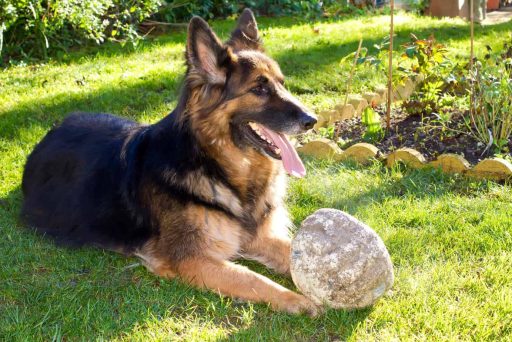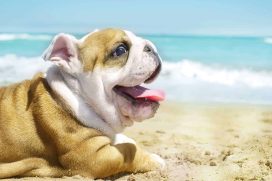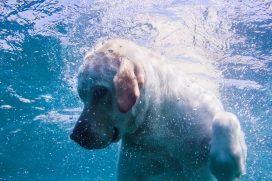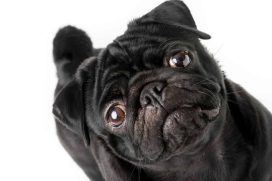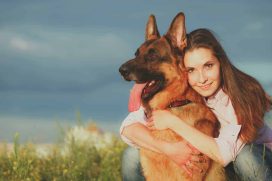When you think of a German Shepherd you probably think of a dog that is sort of a tan color with some black markings on his back, tail, and face. He has medium length fur, not super short and not super long. He has a certain nobility about him and an intelligent look upon his face.
This is the typical German Shepherd that we think of. But did you know that German Shepherds come in other colors, fur lengths, and even double or single coat? To look at some of these different German Shepards you might think that they are not German shepherds at all but some other breed.
What Color Coat Can A German Shepherd Have?
German Shepherds can be solid, sable, saddleback, or bi-color. The coat colors range from black, white, red, tan, blue, cream, liver, and silver.
I should say first, that not all the colors and coat types listed below are recognized as acceptable by all dog clubs such as the AKC. The AKC breed standard of the German Shepherd goes as far as to say that a white German Shepherd must be disqualified!
However, if you do not intend to show your German Shepherd there is no reason to not get a white German Shepherd if you really want one.
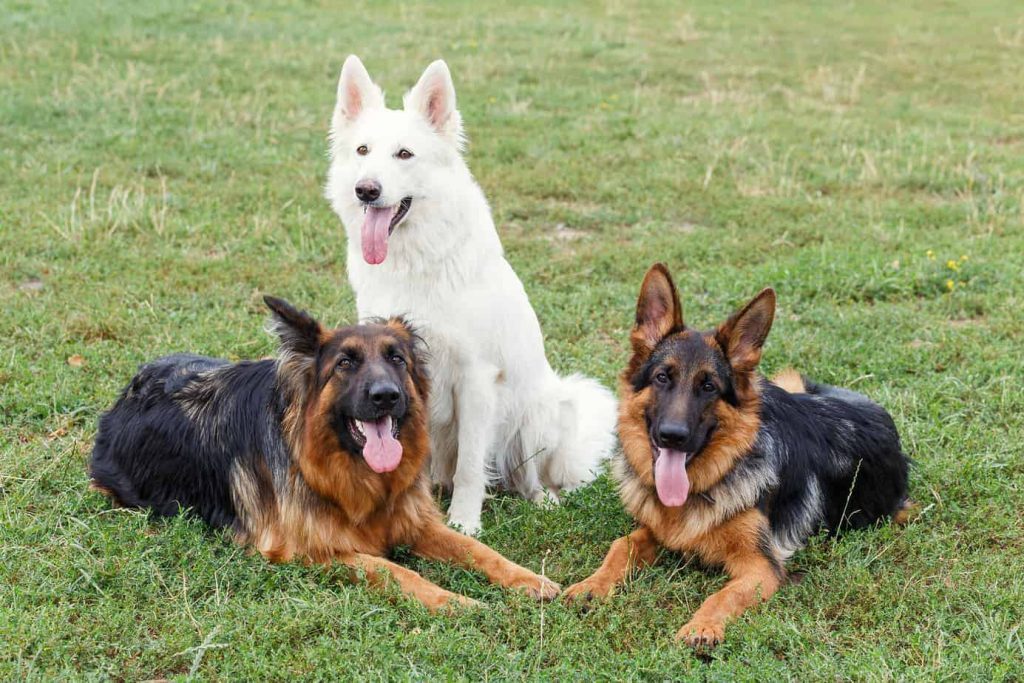
In fact, the color or coat length of a German Shepherd is not known to affect temperament at all in the breed. If the dog is well-bred he should live up to the breed standard of temperament.
German Shepherd Coat Colors Explained
- A solid German Shepherd is just that, all one color. They can be any of the colors of a German Shepherd but the color must cover the whole body.
- For the bi-color German Shepherds, you will see mostly one color with a small amount of another color under the tail, and on the paws. A bi-color will occasionally display the other color on their face, inner ears, jaws, or eyebrows.
- A saddleback German Shepherd is similar to a bi-color. The main difference is that the saddleback shows a lot more of the second color. This is more the typical look you think of when you think of a German Shepherd.
- With a sable German Shepherd, the undercoat will be one color with an overlay of black. The outer coat has alternating color and looks banded. A sable should also have penciling on the toes. The color of a sable German Shepherd can change quite a bit as they age. Some sables will also have more grey than black hair as the overlay. These dogs will usually lack the penciling on the toes. They usually appear to be much lighter in color than a typical sable.
- There is one more color that has been observed in some German Shepherds. This is the “panda” coloring. The dog will have white, black, and tan on it. I guess you could call this a tri-color as well. This coloring is highly argued with most saying that a “panda” is a mixed breed. However, a “panda” puppy has been produced with two purebreed German Shepherd parents.
There can be a variety of coat colors in one litter of German Shepherd puppies. The colors will depend on the color of the parents as well as the genetic heritage.
What Is The Coat Length Of The German Shepherd?
The majority of German Shepherds have a double coat. Meaning that there is a softer, insulating undercoat and a dense, courser outer-coat. This makes the breed very suitable for all types of working environments and weather.
There are some German Shepherds that are considered to have a single coat. Technically these dogs still have a double coat, but the underlayer is so sparse that people call them single coated.
The AKC does not recognize a single coated German Shepherd as acceptable. So through careful breeding, single coated German Shepherds are quite a rare occurrence.
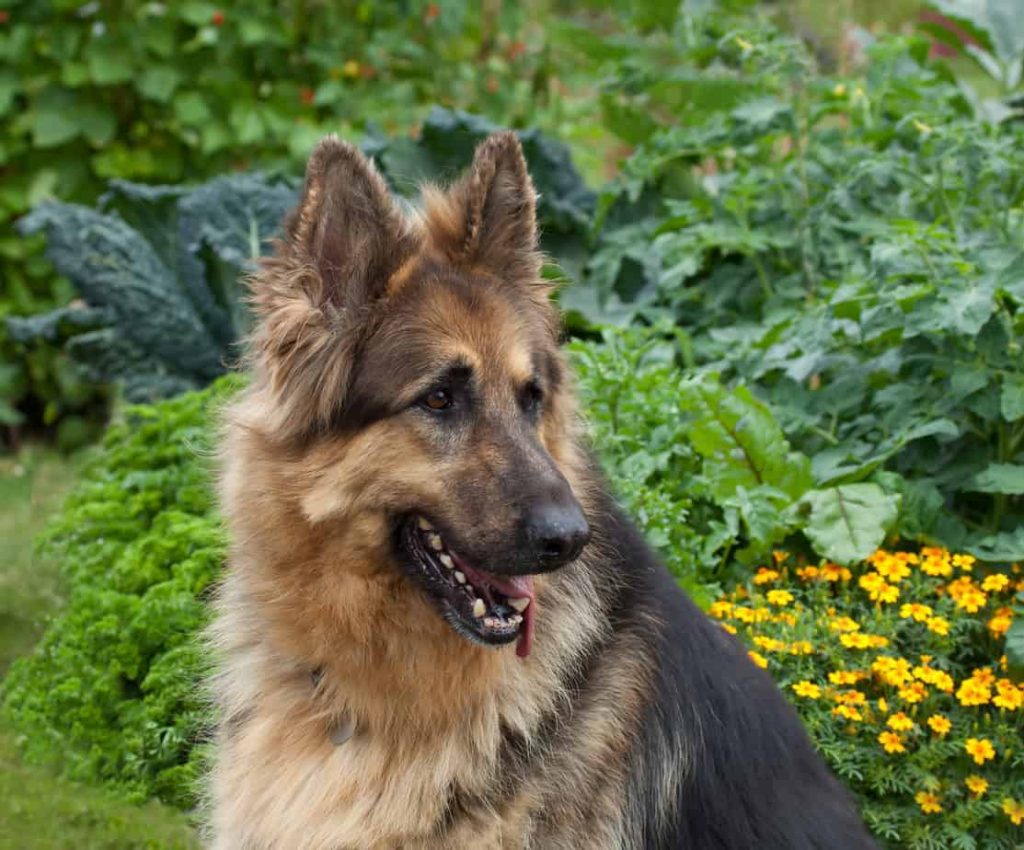
German Shepards may have a shorter coat that appears very smooth and is 1-in long or less. They may also have what is referred to as a “stock” coat. This is slightly longer than the short coat and looks a little rougher.
The breed can also be found in a “plush” coat which is between 1-2 inches long. This coat length is the preferred length of the AKC. And then finally, the breed can be found with a long-haired coat which is anything over 2-inches. The long-coated German Shepherd also has a softer outer coat than the other coat types.
How Do You Take Care Of A German Shepherd Coat?
It is important to note that German Shepherds are heavy shedders. They shed year-round with peak shedding times being spring and fall.
This means that brushings are super important. In spring the heavy undercoat that kept your dog warm all winter is shed. Then in fall, the lighter undercoat is shed in favor of a warmer undercoat.
Short-haired German Shepherds seem to shed more than longer-haired German Shepherds. This is because the undercoat of a long-haired German Shepherd gets caught in the long outer coat. While it might seem nice that a long-haired German Shepherd sheds less, the undercoat that is caught in the long fur will cause mats.
Daily brushing is a good idea for this breed. Not only will this help to minimize shedding, but it is also a great bonding time. Start brushing your German Shepherd daily as soon as you bring him home. This will help to establish the habit and get you both comfortable with brushings.
German Shepherd Daily Brushing Routine
Before you start brushing it’s a good idea to have some treats handy. If your dog handles you working on a mat for 10-minutes without complaint, he deserves a treat.
- Check your dog for mats and tangles. If your dog has a mat, try using a comb. Be gentle with mats, if possible hold the hair bend the mat that is closer to the dog’s skin. This makes it so you can pull the mat toward the body with one hand and pull fur in the mat away from the body with the comb, without causing a ton of pain. Try rubbing some corn starch into the mat as well. The cornstarch helps to loosen things up so you can brush out the mat easier. Also, work on only a small section of the mat at a time vs. trying to pull the whole thing off at once. This will make brushing much more comfortable for the dog.
- Next, use your undercoat rake to loosen the undercoat and brush it out. Start at his head and work back to his tail. Be sure to brush down to the skin. Treats might be handy again in this step. If your dog is sensitive about having any part of his body brushed giving him a few treats while you brush that area can help to ease any tension.
- Once you’ve done the undercoat rake, use a pin brush to remove any stray hairs. A pin brush is mostly going to get the top layer of fur, but it will help to remove any loss undercoat stuck in this top layer.
- Lastly, finish up the brushing session with a bristle brush. This will help to remove those last few loss hairs that are clinging on.
When brushing your German Shepherd, it is a good idea to use long strokes. It is best to stroke in the direction that the fur is growing, vs brushing against it. Brushing against the way the fur grows can be uncomfortable for the dog. Be sure not to press too hard when brushing as well, as this can be quite uncomfortable.
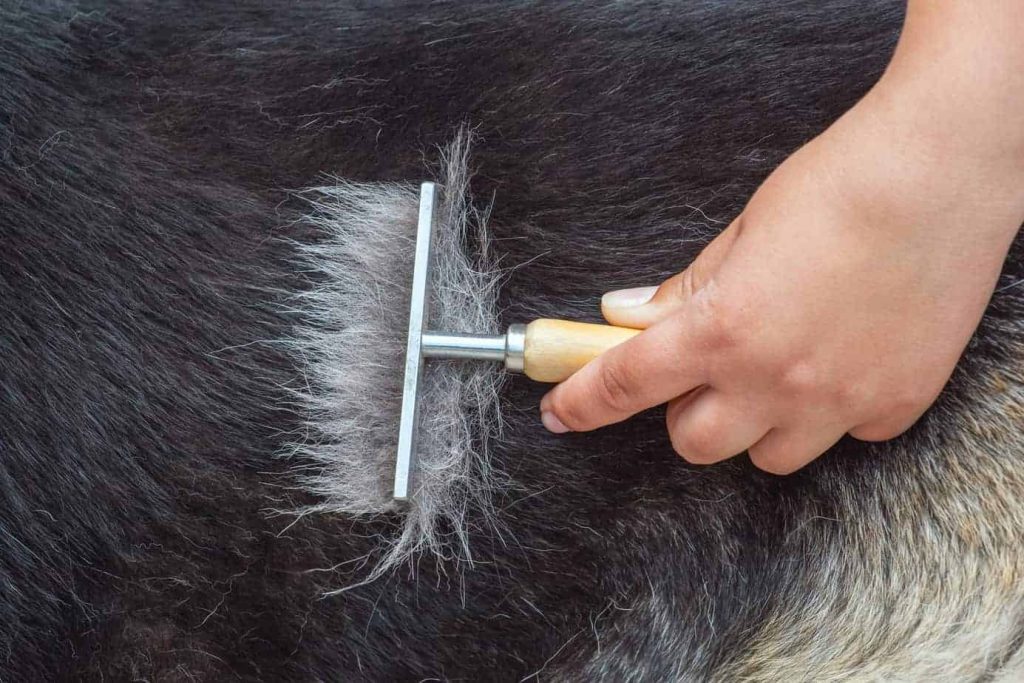
Brushing time can be a great time for bonding with your dog if you are sensitive towards your German Shepherd and treat him with respect. Your dog will not be excited about brushing time if you rip and tear through his fur, it will be a battle for both of you.
However, if you brush gently and do your best to reduce pulling of hair and keep the treats handy, brushing time can be relaxing for the two of you.
Bathing your German Shepherd can help to remove up to 20% more fur. If you brush your dog while he is still a bit damp, that will help to remove even more hair. Do not bathe your dog too often though, as this can strip the natural oils and make your dog’s coat mat easier and have less luster. It is best not to bathe a German Shepherd more than every 4-5 months.
Do not shave a German Shepherd, as they are a double-coated breed. Their under layer of fur may seem like it would be hot year-round, but it helps to regulate the dog’s body temperature even in the summer. Helping him stay warm in the winter and cooler in the summer.
Here’s one of my favourite German Shepherd grooming videos.
How Does Diet Affect The Coat Of The German Shepherd?
A poor-quality diet can lead to a lusterless coat, flaky skin, and excessive shedding in German Shepherds.
Any deficiency in a dog’s diet is often first observed in his coat. It is said that up to 30% of the protein a dog consumes is used to maintain his coat and skin. So, if you feed a low-protein diet, his skin and coat are going to suffer.
Feeding a high-quality, high-protein diet is going to be best for any dog’s skin and coat. A raw diet is ideal for most German Shepherds. Providing plenty of bioavailable protein. A raw-diet is 10% more digestible to dogs, so that’s 10% more protein to add to a lovely and healthy coat.
If you do feed a raw diet, keep the skin, fur, and feathers on if possible. The skin on a chicken is made of many of the same things your German Shepherds’ skin is made out of. So, when your dog eats the skin he is eating nutrients that are specially tuned to help his skin. Likewise, the fur of the rabbit that you are feeding your dog has nutrients that are much like the compounds your dog’s fur is made out of.
There are other things that you could add to a dog’s diet to enhance the look and health of his coat. First, you want to be sure that your dog is getting plenty of omega-3 fatty acids. These fatty acids are great for a dog’s skin and coat as well as his brain, heart, and all his body. Choose from fish oil, salmon oil, krill oil, small fatty fish (like sardines), and phytoplankton as good sources of omega-3s.
Coconut oil is another great addition to your dog’s diet that will support his skin and fur. Coconut oil can be used topically or orally to hydrate the coat and skin. Coconut oil also helps with weight loss, gut health, and brain function. It can also be used to clean teeth, repel fleas and ticks, and it can be used as a disinfectant for small wounds.
Sources
http://steelcross-gsd.com/colours.html
http://images.akc.org/pdf/breeds/standards/GermanShepherdDog.pdf
https://www.dogsnaturallymagazine.com/what-to-feed-your-dog-for-healthy-skin-and-coat/
https://pets.thenest.com/kind-coat-german-shepherds-have-6337.html

